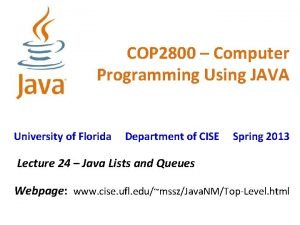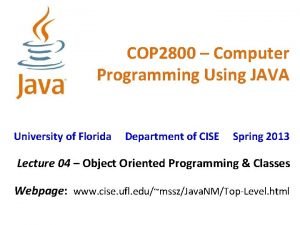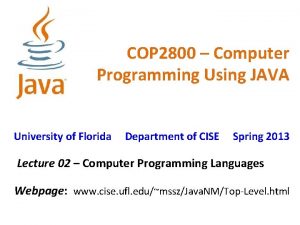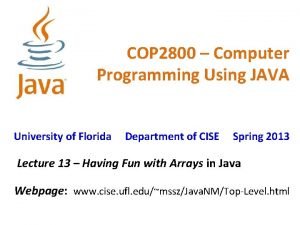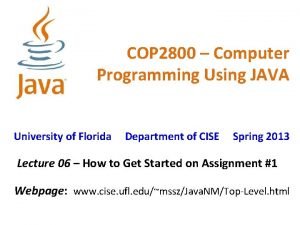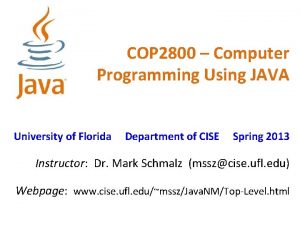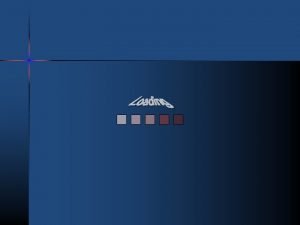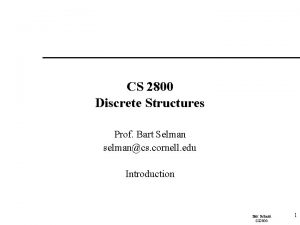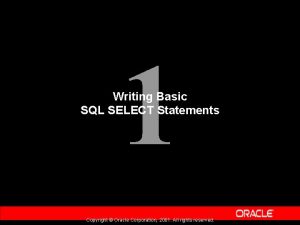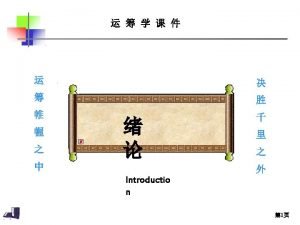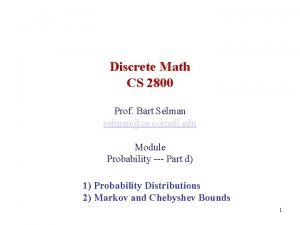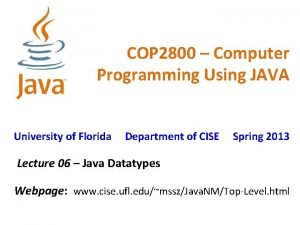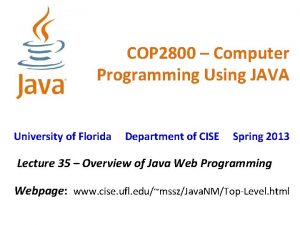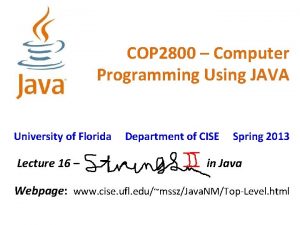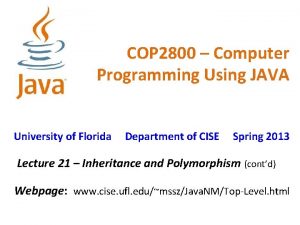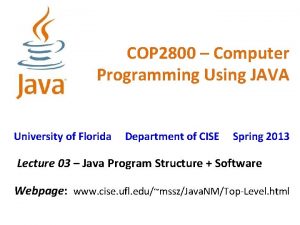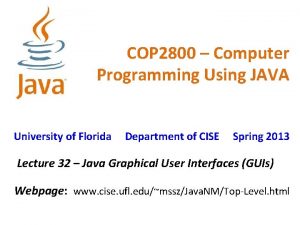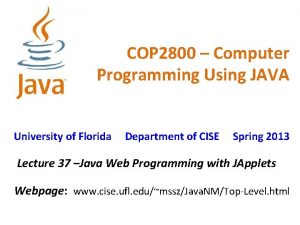COP 2800 Computer Programming Using JAVA University of











![Java Type Conversion (cont’d) Explicit Type Conversion: from-String [String s; ] //String to Double Java Type Conversion (cont’d) Explicit Type Conversion: from-String [String s; ] //String to Double](https://slidetodoc.com/presentation_image_h/039a27ec9279de9872ded92967a335dc/image-12.jpg)



- Slides: 15

COP 2800 – Computer Programming Using JAVA University of Florida Department of CISE Spring 2013 Lecture 10 – Programming with Java Datatypes Type Casting and Type Conversion Webpage: www. cise. ufl. edu/~mssz/Java. NM/Top-Level. html

COP 2800 – Programming in JAVA • Course Objectives – Basic Knowledge of Computers & Programming – Specific Knowledge of JAVA Programming – Practical Programming Projects Build Skills • Today’s Class – What is Type Casting? – Examples of Type Conversion via Type Casting – Look-Ahead at Assignment #2 • Filtering Numbers

Review: Java Program Structure HIGH-LEVEL VIEW PICTURE CREDIT: http: //www. webbasedprogramming. com/JAVA-Developers-Guide/ch 4. htm JAVA Units: - Packages - Classes (Instances) - Methods - Instructions - Variables

Review: Java Package Structure PICTURE CREDIT: http: //users. soe. ucsc. edu/~charlie/book/notes/summary 1 -4/sld 016. htm

New: Java Typecasting A typecast in Java: • One object reference can be type cast into another object reference. • The cast can be to its own class type or to one of its subclass or superclass types or interfaces. • There are compile-time rules and runtime rules for casting in Java

Java Typecasting (cont’d) A typecast in Java can implement implicit type conversion: • Type conversion makes one datatype into another datatype. Ø float double Ø double string Ø int long Ø byte short

Java Typecasting (cont’d) Correct: (float to double) float x = -1. 2343; double y = x ; # 32 bits to 64 bits Incorrect: (float to short) float short x = -1. 23 e-7; y = x ; # 32 bits to 16 bits

Java Typecasting (cont’d) TYPE CONVERSION HIERARCHY: Type Hierarchy: integers: decimals: byte < short < int < long float < double WRONG

Java Type Conversion (cont’d) A float (single-precision floating-point number) • is a positive or negative decimal number • specified by float descriptor (reserved word) • Example: float x = 10. 98 ; Can we convert an int to a float? int x = 6; float y = x; System. out. println(y); Output = 6. 0 “. 0” denotes floating-point

Java Type Conversion (cont’d) Explicit Type Conversion: to-String //Double to String s=Double. to. String(doublevalue); //Long to String s=Long. to. String(longvalue); //Float to String s=Float. to. String(floatvalue);

Java Type Conversion (cont’d) Explicit Type Conversion: to-Int //String to Integer - or - String s=” 7”; int i=Integer. value. Of(s). int. Value(); int i = Integer. parse. Int(s); //Character to Integer char c = ’ 9’; int i =(char)c;
![Java Type Conversion contd Explicit Type Conversion fromString String s String to Double Java Type Conversion (cont’d) Explicit Type Conversion: from-String [String s; ] //String to Double](https://slidetodoc.com/presentation_image_h/039a27ec9279de9872ded92967a335dc/image-12.jpg)
Java Type Conversion (cont’d) Explicit Type Conversion: from-String [String s; ] //String to Double double a=Double. value. Of(s). double. Value(); //String to Long long b=Long. value. Of(s). long. Value(); - or long b=Long. parse. Long(s); //String to Float float x = Float. value. Of(s). float. Value()

NEW: Assignment #2 Part III Vocabulary Terms Simple Numerical Filter Program Numerical Filtering with Arrays and Loops Step 1. Input a number Step 2. Determine to which interval a number belongs Step 3. Keep track of the count of numbers per interval Step 4. Print out the counts of numbers in the intervals

What Code Shall We Start With? From Last Class -- Java Code Fragment: // assign datatypes and initial values to bounds int y = 10, z = 15; // test to see if number is in-range Boolean operator means void test. Number(int x) { logical “and” if ( x <= z && x >= y ) { System. out. println(“Winner!”); } else { System. out. println(“Loser!”); } }

This Week: Java Program Design Next Class (Friday) • How to e-submit Assignment #1 • How to Start Assignment #2, Parts I and II • More on “type casting” Look-Ahead (Monday) • More on Type Casting and Type Conversion • Arrays
